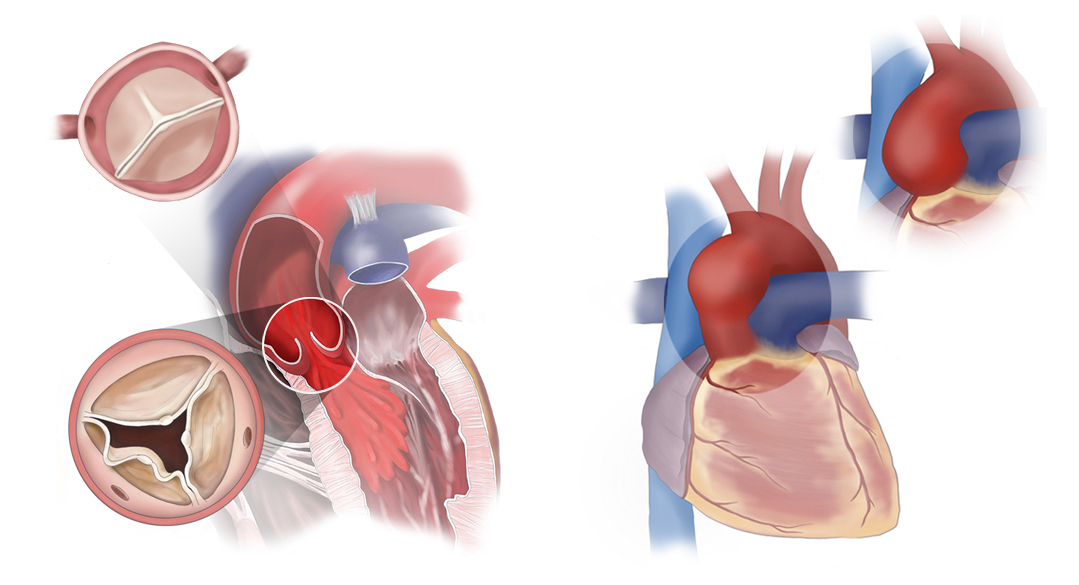HAARTbeat Article
HAART Aortic Valve Repair Technologies
Conditions Associated with Annular Dilatation and Aortic Insufficiency
The HAART Aortic Valve Repair Device reduces annular dilatation and recreates normal leaflet coaptation geometry through internal geometric ring annuloplasty. This new capability greatly expands the variety of treatable pathologies that cause aortic insufficiency and/or annular dilatation. No longer is aortic valve repair limited to patients with aortic root aneurysms.
We’ve worked closely with Dr. Scott Rankin to group the various valve disorders that have already been successfully treated with the HAART devices.

Primary annular dilatation with leaflet defects (left) and ascending and root aneurysms (right)
Primary Annular Dilatation with Leaflet Defects
- Pure Annular Dilatation
- Isolated Leaflet Prolapse
- Ruptured Leaflet Fenestrations
- Traumatic Commissural Rupture
- Rheumatic Aortic Insufficiency
- Healed Endocarditis
Aneurysms
- Ascending Aortic Aneurysms with AI
- Aortic Root Aneurysms with AI
- (video) Tri Leaflet Aortic Root Aneurysms with AI – Aortic Valve Repair and Selective Sinus Remodeling for Aortic Root Aneurysm: Richard S. Downey MD, University of Michigan, Muskegon, MI
- (video) Aortic Valve Repair and Selective Sinus Remodeling for Aortic Root Aneurysm – BioStable training video Richard Downey, MD University of Michigan ‘Blue Dot’ technique
- Syndromic Aneurysms
- Aortic Root Dissections
AI with Concomitant Procedures
- Multiple Valve Disease
- (video) Multiple Valve Disease (Rheumatic Double Valve) – Rheumatic Double Valve Repair Using Two Remodeling Annuloplasty Rings: Richard S. Downey MD, University of Michigan, Muskegon, MI
- (video) Multiple Valve Disease Double Repair (Marfan) – Double Valve Repair for Marfan Aortic Root Aneurysm and Bi-Leaflet (Barlow’s) Mitral Valve Prolapse: George T. Stavridis MD FETCS, Onassis Cardiac Surgery Center, Athens, Greece
- Coronary Artery Bypass with AI
- Destination VAD with AI
Selected Aortic Stenosis
- Nodular Retraction with Insufficiency
- (video) Calcified Unicuspid Valve with Aortic Insufficiency – Unicuspid Aortic Valve Repair using Geometric Ring Annuloplasty: John V. Conte MD, Penn State Health, Hershey, PA
- (video) Release of Retracted Leaflets – ‘Unfolding’ of Retracted Noduli Aranii During Aortic Valve Repair: Steffen Pfeiffer MD, Zentrum für Herzchirurgie Erlangen Nürnberg, Germany
- Aortic Stenosis with Insufficiency
Revision of Previous Valve-Sparing Surgery
- Failed Yacoub Procedure
- Failed David Reimplantation
Bicuspid Aortic Valve (BAV) Defects
- Sievers Type 0 BAV Insufficiency
- Sievers Type 1 BAV Insufficiency
- (video) Sievers Type 1 BAV Insufficiency (no voice) – Repair of a Sievers Type 1 Bicuspid Aortic Valve Defect: John P Kupferschmid MD, Methodist Children’s Hospital, San Antonio, TX
- (video) Minimally Invasive Type 1 BAV Repair – Minimally Invasive Bicuspid Aortic Valve Repair Utilizing HAART Geometric Ring Annuloplasty
- 2 & 3 Leaflet Reconstructions of Variant BAV Defects
Complex Congenital Defects
- Dilated Ross Autograft with AI
- VSD with AI
- LVOT Membrane with AI
- TGA s/p Arterial Switch with Root Aneurysm and AI
- Congenital Aortic Root Aneurysm
- Truncus Valves with AI
- Quadricuspid with AI
Key messages:
- HAART is applicable to a wide variety of pathologies that cause aortic insufficiency.
- HAART standardizes aortic valve repair across the various pathologies through a repeatable and predictable technique.
Accessible aortic valve repair is now a reality with a well-defined patient population. The design of the HAART Aortic Annuloplasty Device enables a simple approach that, at last, brings standardization to this traditionally complex technical procedure. Aortic valve repair has been demonstrated to provide good long-term results with low rates of valve-related events as well as better quality of life.[1,2,3,4]
Now, the HAART Aortic Annuloplasty Devices make aortic valve repair a more standardized and predictable procedure that is applicable to a wide variety of patients with aortic insufficiency. Please take time to educate the referring physicians and make them aware of this exciting new option.
- Baumgartner H, Falk V, Bax JJ, et al. 2017 ESC/EACTS Guidelines for the management of valvular heart disease. Eur Heart J. 2017 Sep 21;38(36):2739-2791.
- Aicher D, Fries R, Rodionycheva S, et al. Aortic valve repair leads to a low incidence of valve-related complications. Eur J Cardiothorac Surg. 2010 Jan;37(1):127-32.
- de Meester C, Pasquet A, Gerber BL, et al. Valve repair improves the outcome of surgery for chronic severe aortic regurgitation: a propensity score analysis. J Thorac Cardiovasc Surg. 2014 Nov;148(5):1913-20.
- Price J, De Kerchove L, Glineur D, et al. Risk of valve-related events after aortic valve repair. Ann Thorac Surg. 2013 Feb;95(2):606-12.
About BioStable Science & Engineering
BioStable Science & Engineering is a cardiovascular device company focused on developing and commercializing proprietary valve repair technologies that provide an alternative to valve replacement for patients with aortic valve disease. The company’s HAART Aortic Repair Technologies are designed to simplify and standardize aortic valve repair, enabling surgeons to offer the recognized clinical benefits of valve repair to patients undergoing surgical correction of aortic insufficiency or aortic root aneurysm.
Please contact us for more information.
